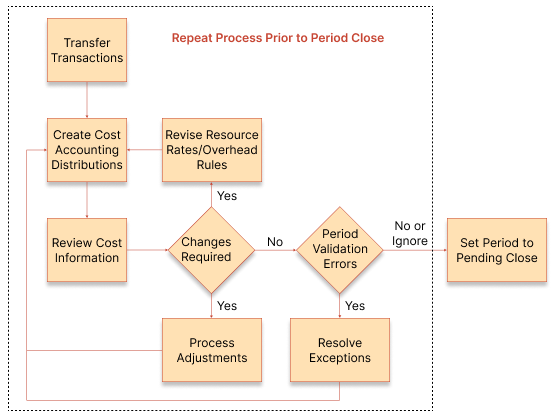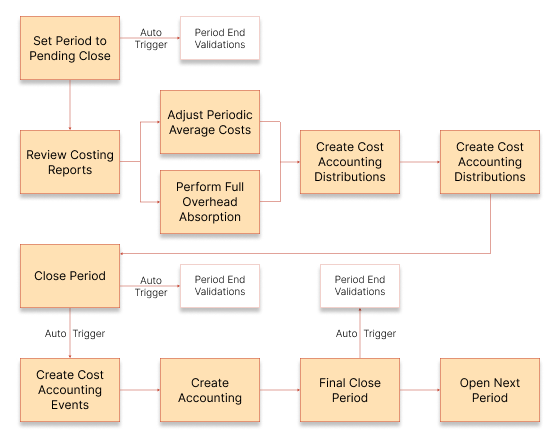Periodic Average Costing Process
When using a periodic average cost enabled cost book, as a cost accountant you need to know the tasks you can perform during the period and the tasks you must perform at period end, for costing and accounting the transactions.
The image here illustrates the periodic average costing process for a period. Its shows the tasks and the sequence in which you can perform them during a period before you set the period status to Pending Close.

In an open period, you can run the various processes to transfer transactions from upstream application to costing. After the transactions are transferred to costing, you run the Create Cost Accounting Distribution process. Unlike other cost methods, when you run this process for a periodic average cost enabled cost book, the distributions created aren’t final. You can run the create cost accounting distributions process multiple times in an open or pending close period. Only after the period is closed, the accounting distributions are frozen.
You can schedule this process to run on a periodic basis and review the distributions created on the Review Cost Accounting Distributions page. If you need to correct the distributions, you can create adjustments by using the Manage Periodic Average Cost Adjustments task in the Cost Accounting work area. You can also revise the resource rates, create and modify overhead rules, and then run the Create Cost Accounting Distribution process again.
As a best practice, you must run the period validations regularly from the Manage Cost Accounting Periods page. You need to review and check for unprocessed transactions, adjustments, under or over absorption on expense pools, processing errors, and so on. Resolving errors and issues, if any, would reduce surprises during period end and make the period end processes smoother.
The image illustrates the tasks specifically to be performed at period end to cost and account the transactions for the period.

At the end of the period, you first set the period status to Pending Close. This ensures that no new transactions are transferred in to costing and a final periodic average cost can be calculated. The period validations for the Pending Close status are automatically run. You must review the exceptions and take necessary corrective measures. You can also review the costing reports for the periodic average cost, inventory value, gross margins, overhead absorption, and resource rate absorption.
Although you can’t transfer new transactions in to costing after you set the period status to Pending Close, you can adjust the costs and process the transactions that are already in costing. You can check the overhead absorption and modify the overhead accounting rules.
You then run the Create Cost Accounting Distributions process. After the distributions are created, you can review the various costing reports like Inventory Valuation and COGS & Gross Margin.
You can now close the period. When you close the period, the period end validations for the Close status are automatically run. Also, the Create Cost Accounting Events process is automatically initiated. Review the validation exceptions and take corrective measure, where necessary.
Run the Create Accounting process in the Final mode to account the transactions and publish them to General Ledger. Set the period status to Permanently Closed. This will automatically run the corresponding period validations. You need to manually open the next period.